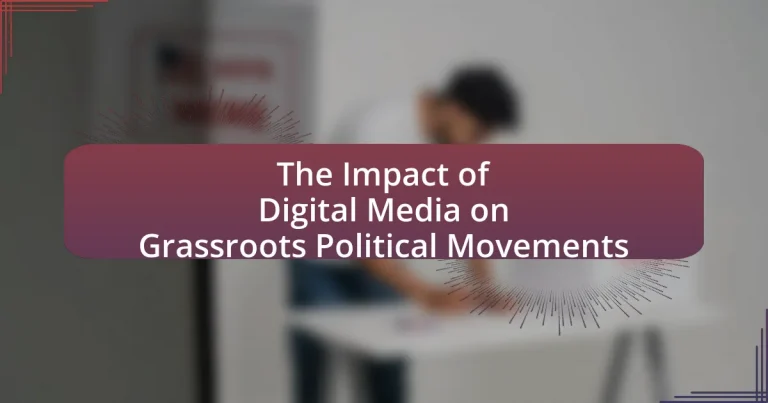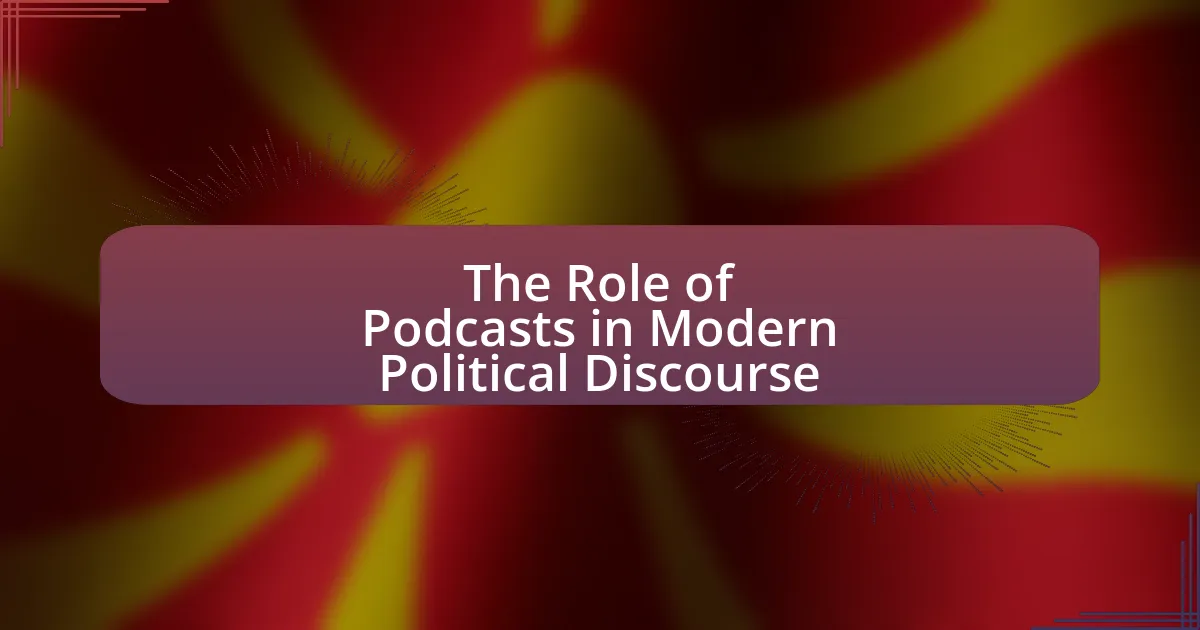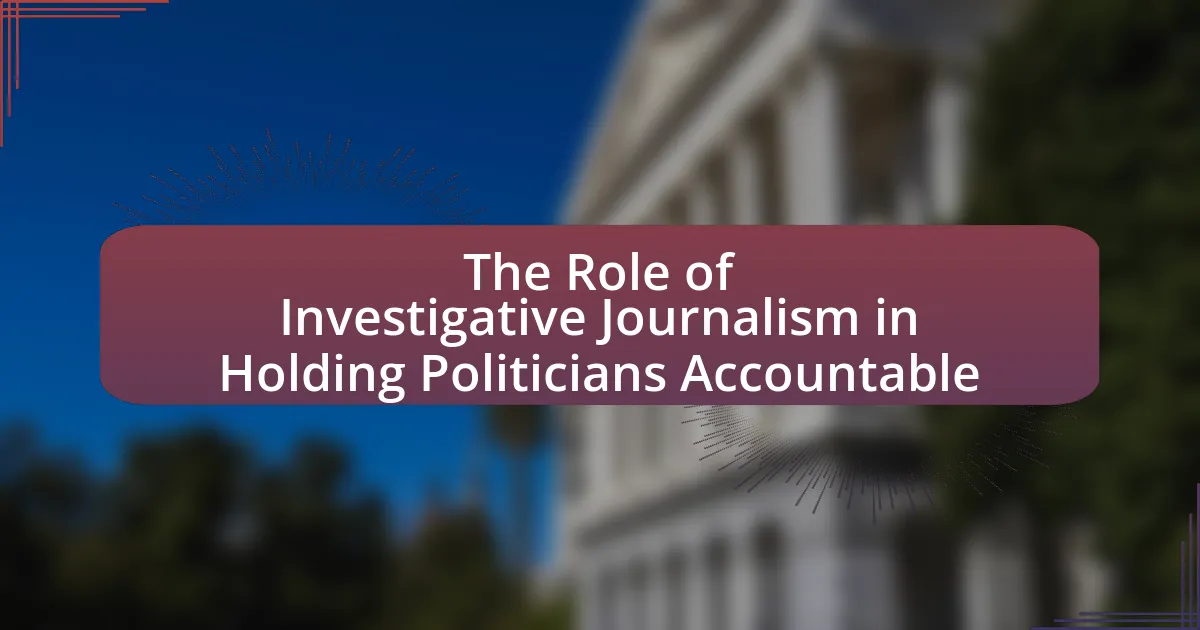The article examines the impact of digital media on grassroots political movements, highlighting how platforms like social media enhance communication, mobilization, and engagement among activists. It discusses key features of digital media, such as accessibility and rapid information dissemination, which facilitate grassroots organization and increase participation rates. The article also addresses challenges faced by these movements, including misinformation, digital surveillance, and algorithmic bias, while emphasizing the importance of storytelling and visual content in driving engagement. Additionally, it explores future trends in technology and best practices for effective digital campaign strategies, drawing on successful case studies to illustrate the transformative role of digital media in grassroots activism.
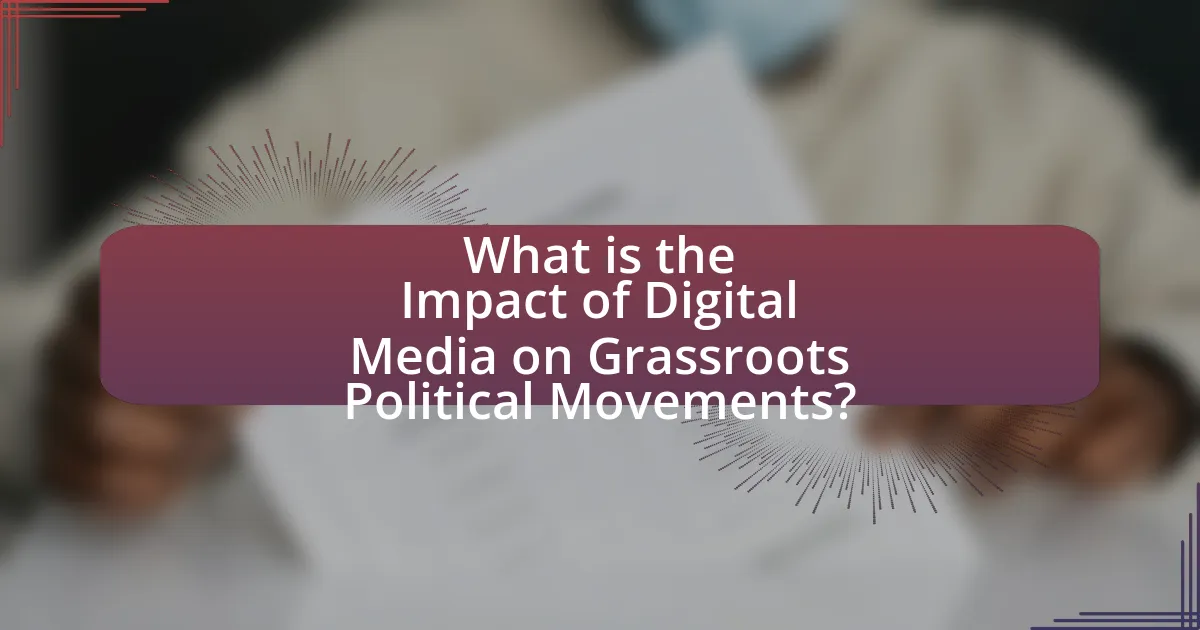
What is the Impact of Digital Media on Grassroots Political Movements?
Digital media significantly enhances grassroots political movements by facilitating rapid communication, mobilization, and engagement among supporters. Platforms like social media allow for the dissemination of information and organization of events at an unprecedented scale, enabling movements to reach wider audiences quickly. For instance, the Arab Spring demonstrated how digital media could mobilize protests and share real-time updates, leading to substantial political change in several countries. Additionally, studies show that campaigns utilizing digital media can increase participation rates; for example, the 2016 U.S. presidential election saw a surge in voter engagement driven by social media outreach. Thus, digital media serves as a crucial tool for grassroots movements, amplifying their voices and impact in the political landscape.
How has digital media transformed grassroots political activism?
Digital media has transformed grassroots political activism by enabling rapid communication, mobilization, and engagement among activists and supporters. Platforms like social media allow grassroots movements to disseminate information quickly, organize events, and rally support on a large scale, often reaching audiences that traditional media cannot. For instance, the Arab Spring in 2010-2011 showcased how social media facilitated coordination and awareness, leading to significant political changes in multiple countries. Additionally, studies indicate that campaigns utilizing digital media can increase participation rates; for example, the 2018 U.S. midterm elections saw a record turnout, partly attributed to online mobilization efforts. This shift has fundamentally altered how grassroots movements operate, making them more inclusive and responsive to real-time events.
What are the key features of digital media that influence grassroots movements?
The key features of digital media that influence grassroots movements include accessibility, rapid information dissemination, and community engagement. Accessibility allows individuals to participate in movements regardless of geographical barriers, as platforms like social media enable widespread communication. Rapid information dissemination facilitates the quick spread of messages and mobilization efforts, exemplified by events like the Arab Spring, where social media played a crucial role in organizing protests. Community engagement fosters a sense of belonging and collective identity among participants, as digital platforms provide spaces for dialogue and collaboration, enhancing the overall effectiveness of grassroots initiatives.
How do social media platforms facilitate grassroots organization?
Social media platforms facilitate grassroots organization by providing accessible communication channels that enable individuals to connect, mobilize, and coordinate efforts around shared causes. These platforms allow users to create and share content rapidly, fostering community engagement and awareness. For instance, during the Arab Spring, social media was instrumental in organizing protests and disseminating information, demonstrating its power in facilitating grassroots movements. Additionally, studies show that 70% of activists reported using social media to organize events, highlighting its effectiveness in grassroots mobilization.
Why is digital media essential for grassroots political movements?
Digital media is essential for grassroots political movements because it enables rapid communication, mobilization, and engagement among supporters. This immediacy allows grassroots organizations to disseminate information quickly, organize events, and rally support on a large scale. For instance, during the Arab Spring, social media platforms like Twitter and Facebook played a crucial role in coordinating protests and sharing real-time updates, demonstrating how digital media can amplify grassroots efforts and facilitate collective action. Additionally, studies show that campaigns utilizing digital media can reach wider audiences at a lower cost, making it a vital tool for grassroots movements aiming to influence public policy and drive social change.
What advantages does digital media provide over traditional media?
Digital media offers several advantages over traditional media, particularly in the context of grassroots political movements. Firstly, digital media provides instant communication, allowing activists to disseminate information rapidly and mobilize supporters in real-time. For example, platforms like Twitter and Facebook enable the sharing of updates and calls to action within seconds, which is crucial during time-sensitive events such as protests.
Additionally, digital media allows for broader reach and engagement, as it can connect individuals across geographical boundaries, fostering a global audience. According to a study by the Pew Research Center, 69% of adults in the U.S. use social media, which significantly amplifies the potential audience for grassroots campaigns compared to traditional media outlets that may have limited distribution.
Moreover, digital media is often more cost-effective than traditional media. Creating and sharing content online typically incurs lower costs than purchasing advertising space in newspapers or on television. This financial accessibility enables grassroots movements, which often operate on limited budgets, to effectively promote their causes.
Lastly, digital media facilitates interactive engagement, allowing supporters to participate actively rather than passively consuming content. This interactivity can enhance community building and foster a sense of ownership among participants, which is vital for the sustainability of grassroots movements.
How does digital media enhance communication among activists?
Digital media enhances communication among activists by providing instant access to information and facilitating real-time interaction. Platforms such as social media enable activists to share updates, mobilize supporters, and coordinate actions quickly, which is crucial during time-sensitive events like protests. For instance, during the Arab Spring, activists utilized Twitter and Facebook to organize demonstrations and disseminate information rapidly, leading to widespread participation and global awareness. This immediacy and reach of digital media empower activists to connect with a broader audience, fostering solidarity and collaboration across geographical boundaries.
What challenges do grassroots movements face in the digital landscape?
Grassroots movements face significant challenges in the digital landscape, primarily including information overload, algorithmic bias, and digital surveillance. Information overload occurs as activists struggle to capture attention amidst a vast amount of content, making it difficult to convey their messages effectively. Algorithmic bias can limit the visibility of grassroots content, as social media platforms often prioritize mainstream narratives over marginalized voices, hindering outreach efforts. Additionally, digital surveillance poses a threat to activists’ privacy and security, as governments and corporations monitor online activities, potentially leading to repression or harassment. These challenges collectively undermine the effectiveness and safety of grassroots movements in the digital realm.
How do misinformation and disinformation affect grassroots campaigns?
Misinformation and disinformation significantly undermine grassroots campaigns by eroding trust and distorting public perception. Grassroots movements rely on community engagement and credibility; when false information circulates, it can mislead supporters and create divisions within the community. For instance, a study by the Pew Research Center found that 64% of Americans believe misinformation has a major impact on their understanding of political issues, which directly affects grassroots mobilization efforts. Furthermore, disinformation campaigns can divert resources and attention away from legitimate issues, leading to confusion and apathy among potential supporters. This dynamic illustrates how misinformation and disinformation can disrupt the foundational elements of grassroots activism, ultimately hindering their effectiveness.
What are the risks of digital surveillance for grassroots activists?
Digital surveillance poses significant risks for grassroots activists, primarily by compromising their privacy and safety. Surveillance can lead to the identification of activists, making them vulnerable to harassment, arrest, or violence from authorities or opposing groups. For instance, the use of facial recognition technology has been documented in various protests, enabling law enforcement to track and target individuals involved in activism. Additionally, digital surveillance can deter participation in movements, as individuals may fear repercussions from their online activities being monitored. Reports indicate that in countries with high surveillance, such as China, activists face severe consequences, including imprisonment, due to their online presence and communications being scrutinized. Thus, the risks of digital surveillance fundamentally threaten the operational security and effectiveness of grassroots movements.
How do grassroots movements utilize digital media effectively?
Grassroots movements utilize digital media effectively by leveraging social media platforms to mobilize supporters, disseminate information rapidly, and create a sense of community. For instance, platforms like Twitter and Facebook enable these movements to reach a wide audience quickly, facilitating real-time communication and engagement. Research indicates that during the Arab Spring, social media played a crucial role in organizing protests and spreading awareness, demonstrating its power in grassroots activism. Additionally, digital media allows for targeted messaging, enabling movements to tailor their outreach to specific demographics, thereby increasing participation and support.
What strategies do successful grassroots movements employ on social media?
Successful grassroots movements employ targeted messaging, community engagement, and strategic use of hashtags on social media. Targeted messaging allows movements to resonate with specific audiences, increasing the likelihood of engagement and support. Community engagement fosters a sense of belonging and encourages individuals to participate actively, as seen in movements like Black Lives Matter, which utilized social media to mobilize protests and share personal stories. Strategic use of hashtags, such as #MeToo, amplifies visibility and connects diverse voices, facilitating broader conversations and solidarity. These strategies have proven effective in mobilizing support and driving social change.
How can grassroots movements measure the impact of their digital campaigns?
Grassroots movements can measure the impact of their digital campaigns through metrics such as engagement rates, conversion rates, and social media reach. Engagement rates, which include likes, shares, and comments, indicate how well the content resonates with the audience. Conversion rates, which track actions taken by users such as signing petitions or donating, provide insight into the effectiveness of the campaign in achieving its goals. Social media reach measures the total number of unique users who see the campaign content, helping to assess the overall visibility and awareness generated. According to a study by the Pew Research Center, 69% of Americans use social media, highlighting its potential as a powerful tool for grassroots movements to gauge their digital campaign effectiveness.

What role does digital media play in mobilizing support for grassroots movements?
Digital media plays a crucial role in mobilizing support for grassroots movements by facilitating rapid communication and broadening outreach. It enables activists to share information, organize events, and engage supporters through platforms like social media, which can reach millions instantly. For instance, the #BlackLivesMatter movement utilized Twitter and Facebook to raise awareness and mobilize protests, demonstrating how digital media can amplify voices and coordinate actions effectively. Research indicates that social media campaigns can significantly increase participation in grassroots initiatives, as seen in the Arab Spring, where platforms like Facebook were instrumental in organizing protests against authoritarian regimes.
How do online petitions and campaigns drive engagement?
Online petitions and campaigns drive engagement by facilitating direct participation and mobilizing communities around shared causes. These digital tools enable individuals to express their opinions, share their stories, and rally support, often leading to increased visibility and awareness of specific issues. For instance, a study by the Pew Research Center found that 70% of online petition signers reported feeling more engaged in civic activities after participating in such campaigns. This engagement is further amplified through social media sharing, which allows petitions to reach broader audiences and encourages collective action, thereby enhancing the overall impact of grassroots movements.
What platforms are most effective for launching digital petitions?
The most effective platforms for launching digital petitions are Change.org, Care2, and Avaaz. Change.org is widely recognized for its user-friendly interface and extensive reach, boasting over 200 million users globally, which enhances the visibility of petitions. Care2 focuses on social activism and has a dedicated community of over 30 million members, making it effective for environmental and social justice causes. Avaaz, with its global network of over 65 million members, excels in mobilizing support for urgent issues, allowing petitions to gain traction quickly. These platforms have proven successful in driving grassroots movements and influencing policy changes through their large user bases and targeted outreach capabilities.
How do viral campaigns influence public opinion and participation?
Viral campaigns significantly influence public opinion and participation by rapidly disseminating messages that resonate emotionally with audiences. These campaigns leverage social media platforms to amplify their reach, often resulting in increased awareness and engagement on specific issues. For instance, the Ice Bucket Challenge in 2014 raised over $115 million for ALS research, demonstrating how a viral campaign can mobilize public support and participation in a cause. Additionally, studies show that viral content can shape perceptions and attitudes, as seen in the 2016 U.S. presidential election, where social media played a crucial role in influencing voter opinions and turnout.
What is the significance of storytelling in digital grassroots movements?
Storytelling is significant in digital grassroots movements because it fosters emotional connections and mobilizes support among diverse audiences. By sharing personal narratives and experiences, movements can humanize complex issues, making them relatable and compelling. For instance, the #MeToo movement utilized storytelling to highlight individual experiences of sexual harassment, which galvanized widespread public engagement and advocacy for policy changes. This approach not only raises awareness but also encourages collective action, as evidenced by the increased participation in protests and discussions surrounding the movement. Thus, storytelling serves as a powerful tool for building community, driving engagement, and effecting social change within digital grassroots initiatives.
How can personal narratives enhance the effectiveness of campaigns?
Personal narratives enhance the effectiveness of campaigns by creating emotional connections that resonate with audiences. These narratives humanize issues, making them relatable and compelling, which can increase engagement and support. Research indicates that storytelling can significantly boost message retention; for instance, a study published in the journal “Psychological Science” found that narratives can improve recall by up to 22 times compared to non-narrative information. This heightened recall can lead to greater advocacy and mobilization within grassroots movements, as individuals are more likely to share and act upon stories that evoke empathy and personal relevance.
What role does visual content play in storytelling for activism?
Visual content serves as a powerful tool in storytelling for activism by enhancing emotional engagement and facilitating information retention. Research indicates that visuals can increase message retention by up to 65% compared to text alone, making them crucial for conveying complex social issues effectively. For instance, images and videos can evoke empathy and urgency, prompting viewers to take action, as seen in campaigns like the Ice Bucket Challenge, which utilized compelling visuals to raise awareness and funds for ALS. This demonstrates that visual content not only captures attention but also drives participation in grassroots movements, amplifying their impact in the digital landscape.
How do grassroots movements build online communities through digital media?
Grassroots movements build online communities through digital media by leveraging social platforms to connect individuals with shared interests and goals. These movements utilize tools such as social media, blogs, and forums to disseminate information, mobilize supporters, and foster engagement. For instance, the Black Lives Matter movement effectively used Twitter and Facebook to organize protests and share resources, resulting in a significant increase in community participation and awareness. Research indicates that 70% of activists reported that social media played a crucial role in their engagement with grassroots initiatives, highlighting the effectiveness of digital media in creating and sustaining online communities.
What tools do activists use to foster community engagement online?
Activists use social media platforms, email newsletters, and online petition tools to foster community engagement online. Social media platforms like Facebook, Twitter, and Instagram allow activists to reach a broad audience, share information quickly, and mobilize supporters for events or campaigns. Email newsletters enable direct communication with supporters, providing updates and calls to action. Online petition tools, such as Change.org, facilitate collective action by allowing individuals to sign and share petitions, amplifying their voices on specific issues. These tools have been shown to significantly enhance community involvement and awareness, as evidenced by the success of various movements that utilized them to organize and engage supporters effectively.
How can online communities support offline activism?
Online communities can support offline activism by facilitating organization, mobilization, and awareness-raising among activists. These digital platforms enable individuals to connect, share resources, and coordinate events, which is crucial for effective grassroots movements. For instance, social media campaigns can quickly disseminate information about protests or community meetings, leading to higher turnout rates. Research indicates that online engagement can significantly increase participation in offline events; a study by the Pew Research Center found that 69% of social media users have taken some form of political action as a result of online interactions. This demonstrates that online communities play a vital role in bridging the gap between digital engagement and physical activism.
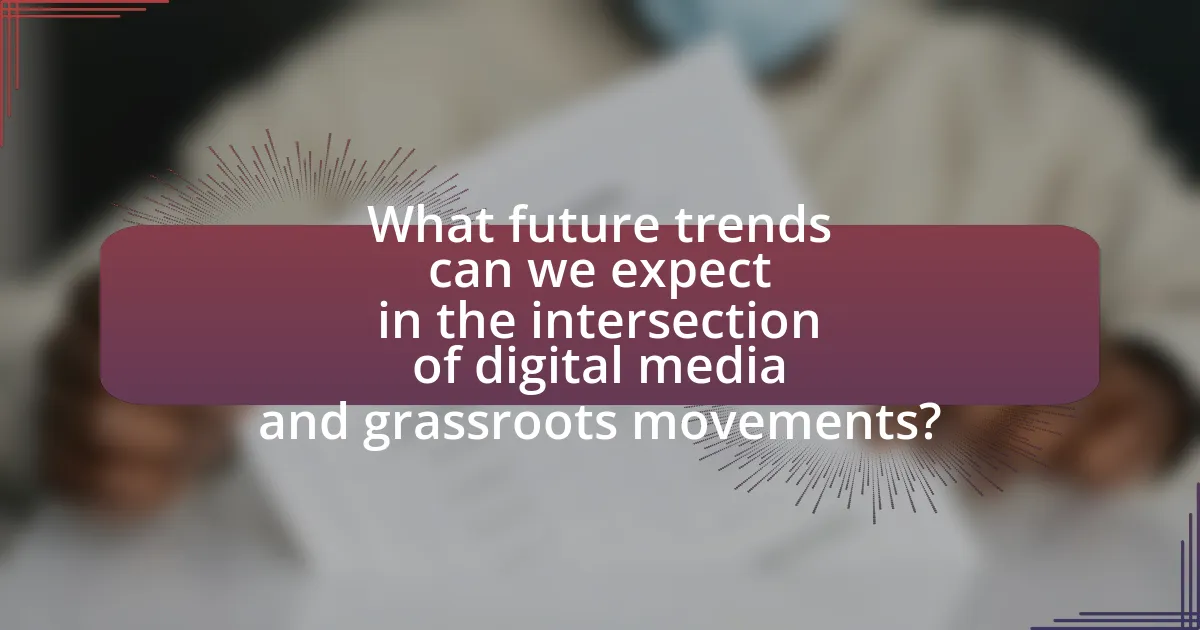
What future trends can we expect in the intersection of digital media and grassroots movements?
Future trends in the intersection of digital media and grassroots movements include increased use of artificial intelligence for targeted messaging and enhanced data analytics to mobilize supporters effectively. As grassroots movements leverage AI tools, they can analyze vast amounts of data to identify key demographics and tailor their outreach strategies, leading to more efficient campaigns. Additionally, the rise of decentralized social media platforms is expected to empower grassroots organizations by providing alternative spaces for engagement, reducing reliance on traditional platforms that may impose restrictions. Research indicates that movements utilizing these technologies have seen significant increases in participation and funding, exemplified by the success of campaigns like the Black Lives Matter movement, which effectively utilized social media to amplify their message and mobilize supporters globally.
How is technology evolving to support grassroots activism?
Technology is evolving to support grassroots activism by providing accessible platforms for communication, organization, and mobilization. Social media networks, such as Twitter and Facebook, enable activists to share information rapidly, reach wider audiences, and coordinate events effectively. For instance, the Arab Spring demonstrated how platforms like Facebook facilitated the organization of protests, leading to significant political changes in several countries. Additionally, crowdfunding platforms allow grassroots movements to raise funds directly from supporters, bypassing traditional funding sources. According to a report by the Pew Research Center, 69% of Americans believe social media is an effective tool for political engagement, highlighting its role in empowering grassroots activism.
What emerging platforms are likely to influence future movements?
Emerging platforms likely to influence future movements include TikTok, Clubhouse, and decentralized social networks like Mastodon. TikTok’s algorithm promotes viral content, enabling rapid dissemination of grassroots messages, as seen in movements like Black Lives Matter, where short videos mobilized global support. Clubhouse facilitates real-time discussions, allowing activists to engage directly with audiences and share experiences, which can amplify their reach and impact. Decentralized social networks like Mastodon offer alternatives to mainstream platforms, promoting privacy and user control, which can attract users concerned about censorship and data privacy, thus fostering diverse political discourse.
How can artificial intelligence enhance grassroots organizing?
Artificial intelligence can enhance grassroots organizing by optimizing data analysis and improving communication strategies. AI tools can analyze large datasets to identify potential supporters, assess community needs, and tailor messaging effectively. For instance, machine learning algorithms can process social media interactions to gauge public sentiment, allowing organizers to adapt their campaigns in real-time. Additionally, AI-driven chatbots can facilitate engagement by providing instant responses to inquiries, thus increasing participation rates. Research indicates that organizations utilizing AI for outreach have seen a 30% increase in volunteer sign-ups, demonstrating the tangible benefits of integrating AI into grassroots efforts.
What best practices should grassroots movements adopt for digital engagement?
Grassroots movements should adopt a multi-channel digital strategy for effective engagement. This involves utilizing social media platforms, email campaigns, and websites to reach diverse audiences. Research indicates that movements leveraging multiple channels can increase their visibility and engagement rates significantly; for example, a study by the Pew Research Center found that 69% of adults in the U.S. use social media, making it a crucial tool for outreach. Additionally, grassroots movements should prioritize authentic storytelling to connect emotionally with supporters, as narratives can drive higher engagement levels. According to a report by the Stanford Social Innovation Review, storytelling can increase donations and volunteer sign-ups by up to 300%. Finally, movements must analyze engagement metrics to refine their strategies continuously, ensuring that they adapt to the changing digital landscape and audience preferences.
How can grassroots organizations effectively utilize data analytics?
Grassroots organizations can effectively utilize data analytics by leveraging data to identify community needs, track engagement, and measure the impact of their initiatives. By analyzing demographic data, organizations can tailor their outreach efforts to specific populations, ensuring that their messaging resonates with target audiences. For instance, a study by the Pew Research Center found that data-driven campaigns can increase voter turnout by up to 20% when they are personalized based on community insights. Additionally, using analytics tools allows these organizations to monitor social media engagement, enabling them to adjust strategies in real-time based on what content drives the most interaction. This data-centric approach not only enhances decision-making but also optimizes resource allocation, ultimately leading to more effective advocacy and mobilization efforts.
What are the key elements of a successful digital campaign strategy?
The key elements of a successful digital campaign strategy include clear objectives, targeted audience identification, engaging content, effective use of social media platforms, and data analytics for performance measurement. Clear objectives guide the campaign’s direction, ensuring all efforts align with specific goals. Targeted audience identification allows for tailored messaging that resonates with specific demographics, increasing engagement. Engaging content, such as videos and infographics, captures attention and encourages sharing. Effective use of social media platforms maximizes reach and interaction, as platforms like Facebook and Twitter are crucial for grassroots movements. Finally, data analytics provide insights into campaign performance, enabling adjustments for improved outcomes. These elements collectively enhance the effectiveness of digital campaigns in mobilizing support and driving action.
What lessons can be learned from past grassroots movements using digital media?
Past grassroots movements using digital media demonstrate the importance of rapid information dissemination, community engagement, and strategic messaging. For instance, the Arab Spring in 2010-2011 showcased how platforms like Twitter and Facebook enabled activists to organize protests and share real-time updates, leading to significant political changes in several countries. Additionally, the Black Lives Matter movement utilized social media to amplify voices and mobilize supporters globally, illustrating the effectiveness of digital storytelling in raising awareness about social justice issues. These examples highlight that successful grassroots movements leverage digital media to create networks, foster solidarity, and influence public opinion, ultimately driving social and political change.
What successful case studies illustrate the impact of digital media?
Successful case studies illustrating the impact of digital media include the Arab Spring and the Black Lives Matter movement. The Arab Spring, which began in 2010, utilized social media platforms like Facebook and Twitter to organize protests, share information, and mobilize support, leading to significant political changes in countries like Tunisia and Egypt. Research by the Berkman Klein Center for Internet & Society at Harvard University highlights that social media played a crucial role in facilitating communication and coordination among activists, demonstrating its power in grassroots movements.
Similarly, the Black Lives Matter movement, which gained momentum in 2013, effectively leveraged digital media to raise awareness about racial injustice and police brutality. The hashtag #BlackLivesMatter became a rallying cry, allowing activists to share personal stories, organize protests, and engage a global audience. A study published in the Journal of Communication found that social media campaigns significantly increased public awareness and support for the movement, showcasing the effectiveness of digital media in driving social change.
How can failures inform future grassroots digital strategies?
Failures can inform future grassroots digital strategies by providing critical insights into what does not resonate with the target audience and highlighting areas for improvement. Analyzing past failures allows organizations to identify ineffective messaging, poor platform choices, or inadequate engagement tactics. For instance, the 2016 U.S. presidential election saw various grassroots campaigns struggle due to misalignment with voter concerns, demonstrating the importance of audience research and adaptability. By learning from these missteps, future strategies can be tailored to better meet the needs and preferences of constituents, ultimately enhancing engagement and effectiveness in mobilizing support.
